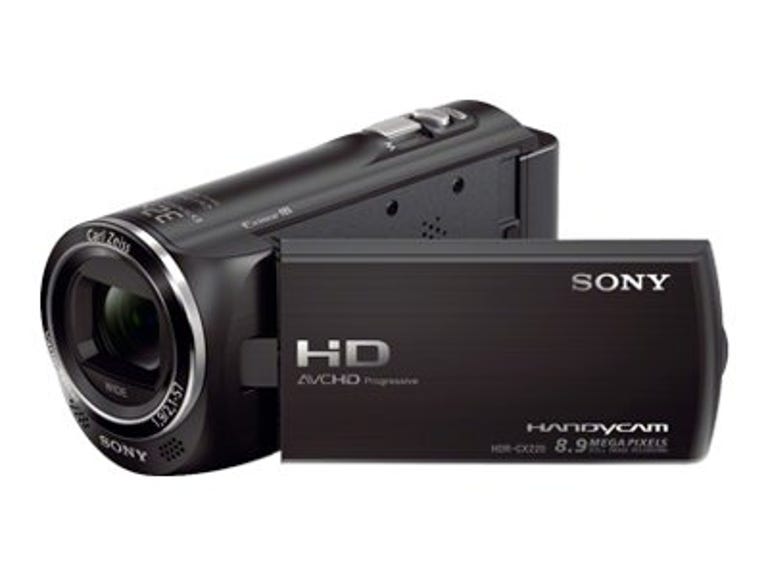 Why You Can Trust CNET
Why You Can Trust CNET Sony Handycam HDR-CX220 review: Cheap, but you get what you pay for
It costs less than $200, but pricing like that is usually comes at a cost.
I don't review as many camcorders as I used to, mostly because of limited bandwidth; cameras require a lot more of my time and there's more reader interest. Occasionally, though, readers express enough interest in a model to pop it onto my review radar. That's my rationale for looking at the Sony Handycam HDR-CX220, the replacement for the popular CX190. Popular for no reason I can fathom other than it offers a long lens at a cheap price of just under $200. With no features to speak of, a confusing interface and mediocre video quality, though, I recommend saving your money.
The Good
The Bad
The Bottom Line
The CX220 is essentially the same model in terms of image quality as Sony's CX230 (8GB built-in memory), CX290 (8GB plus optical image stabilization and touch screen), and PJ230 (8GB plus built-in projector) -- they all have the same sensor and lens.
The design is typical of a traditional camcorder, and it's extremely lightweight -- one might even say flimsy-feeling. I was surprised that I managed to cram it into a loose jeans pocket when I needed an extra hand, though. It's got a built-in lens cover and a USB charging cable that tucks into the strap, which will work with any USB charger. (A shout-out to all you confused Amazon reviewers.) If you don't own a modern phone or tablet charger or have a computer to plug it into, Sony will ask you to fork over about $20 for its version or you can buy one for between $5 and $10. Rather than bundling a charger, Sony opts to include a Micro-HDMI cable for connection to a TV.
| Sensor | 1/5.8-inch Exmor R (BSI) CMOS |
| Gross pixel count | 2.4 megapixels |
| Sufficient pixels for 1080p video | Yes |
| Actual photo resolution | 2.3 megapixels |
| Interpolated photo resolution for marketing purposes | 8.9 megapixels |
| Highest quality video | 1080/60p 28Mbps AVCHD |
| Default video quality | 1440/60i 9Mbps AVCHD |
| Built-in memory | None |
| Lens | 29.8-953.6mm f1.9 - f4 27X |
| Image stabilization | Electronic |
| Closest focus | 0.4 inch |
| LCD | 2.7-inch articulated 230,000 dot |
| Size | 2.1x2.3x4.6 inches |
| Weight | 7.7 ounces |
| Manufacturer price | $199.99 |
| Availability | February 2013 |
The LCD is small and low-resolution, and the colors it displays bear no relation to the colors as rendered in the videos. There's a joystick on the LCD bezel for awkwardly navigating the menus through a poorly designed interface. I lost an afternoon's testing because I thought I'd switched the video settings, but the camcorder makes you jump through so many confusing screens -- do I click OK? Next? "X"? -- that it turns out I hadn't actually successfully changed them.
And you really do need to change the defaults. The out-of-the-box video quality is set to 1440x1,080 60i (interlaced) at a bit rate of 9 megabits per second. If that doesn't mean anything to you, that's state-of-the-art -- for 2008. It's awful. Switching to the best quality of 1080/60p delivers something more along the lines of what I'd expect for $200, but it's still pretty mediocre. Mushy and bleeding edges, poor tonal range...if all you're looking for is to be able to show someone's doing something then it might suffice. You can get better video quality out of a standard camera like the Canon PowerShot SX260 HS, with its 20X zoom lens, for about the same price. The video quality is identical to last year's model, the CX190. Also, you'll probably get better still photos from your phone.
The autofocus works pretty well, though the video is soft enough that you'd be forgiven for thinking it's not in focus, and like all AF systems it makes pretty poor choices about what the subject of the scene is. It does focus quickly, though. The electronic image stabilization is on par with the image quality -- that is, just OK.
When you power on the camcorder it points you online to download Sony's PlayMemories Home software, which is Windows-only. Mac users aren't missing anything, though; AVCHD is now well supported by all third-party applications (here are instructions for downloading video on a Mac) and the best thing I can say about PlayMemories is it's free.
If you're looking for an action camera, image quality is secondary to mountability, but the fact remains that you have to pay at least $400 for a base model that delivers decent quality.


